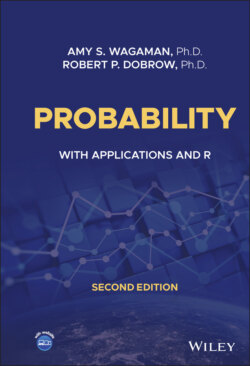Читать книгу Probability - Robert P. Dobrow - Страница 32
COUNTING k-ELEMENT SUBSETS AND LISTS WITH k ONES
ОглавлениеThere are -element subsets of .
There are binary lists of length with exactly ones.
There are ways to select a subset of objects from a set of objects when the order the objects are selected in does not matter.
Binomial coefficients are defined for nonnegative integers and , where . For or , set Common values of binomial coefficients are given in Table 1.4.
Example 1.20 A classroom of ten students has six females and four males. (i) What are the number of ways to pick five students for a project? (ii) How many ways can we pick a group of two females and three males?
1 There are ways to pick five students.
2 There are ways to pick the females, and ways to pick the males. By the multiplication principle, there are ways to pick the group.
Example 1.21 In a poker game, players are dealt five cards from a standard deck of 52 cards as their starting hand. The best hand in the game of poker is a royal straight flush consisting of 10-Jack-Queen-King-Ace, all of the same suit. What is the probability of getting dealt a royal straight flush?There are four possible royal straight flushes, one for each suit. A five-card hand in poker is a five-element subset of a 52-element set. Thus,or about 1.5 in a million.
Example 1.22 Texas hold 'em. In Texas hold 'em poker, players are initially dealt two cards from a standard deck. What is the probability of being dealt at least one ace?Consider the complementary event of being dealt no aces. There are ways of being dealt two cards neither of which are aces. The desired probability is
Example 1.23 Twenty-five people will participate in a clinical trial, where 15 people receive the treatment and 10 people receive the placebo. In a group of six people who participated in the trial, what is the probability that four received the treatment and two received the placebo?There are ways to pick the four who received the treatment, and ways to pick the two who received the placebo. There are possible subgroups of six people. The desired probability is
Example 1.24 Powerball lottery. In the Powerball lottery, the player picks five numbers between 1 and 59 and then a single “powerball” number between 1 and 35. To win the jackpot, you need to match all six numbers. What is the probability of winning the jackpot?There are possible plays. Of these, one is the jackpot winner. The desired probability isor almost 1 out of 200 million.You can win $10,000 in the Powerball lottery if you match the powerball and exactly four of the other five numbers. The number of ways to make such a match is . This is accomplished by selecting the matching powerball , four of the five selected nonpowerball numbers , and one of the remaining nonselected nonpowerball numbers . Note that the coefficient for selecting the powerball winner is not shown in the computation. This is a common convention for coefficients that evaluate to 1 or , as shown below with . The probability of winning $10,000 in Powerball is thusabout the same as the probability of being dealt a royal straight flush in poker.
Example 1.25 Bridge. In the game of bridge, all 52 cards are dealt out to four players. Each player gets 13 cards. A perfect bridge hand is getting all cards of the same suit. (i) What is the probability of being dealt a perfect hand? (ii) What is the probability that all four players will be dealt perfect hands?
1 There are possible bridge hands. Of those, four contain all the same suit. Thus, the probability of being dealt a perfect hand is
2 There are ways for the first player to be dealt 13 cards. Then ways to deal the remaining 39 cards to the second player, and so on. There arepossible ways to deal out the deck. Perfect hands differ by the suit. And there are ways to permute the four suits among the four players. The desired probability is
